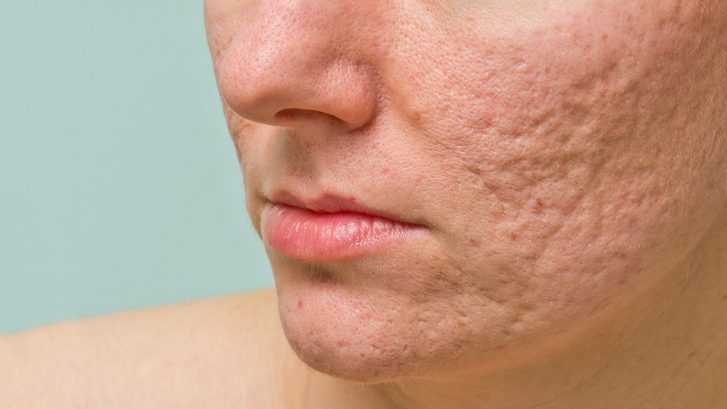Can Botox Help with Acne Scars?
Growing up is hard enough without the added stress (and distress) of acne. Many of us endure this indignity during our teen years, but acne isn’t exclusive to adolescents… and the scarring from facial blemishes can last long after the initial bout of inflammation has dissipated.
While the skin care aisle is flooded with products to help consumers fend off oily skin and other agents that cause acne, what about its residual effects? How can you replenish your skin after it has been adversely affected by acne, either in your youth or beyond?
Doctor Binder has an answer that may surprise you.
After engineering, the use of Botox for groundbreaking uses such as migraine alleviation and the cessation of profuse sweating, Binder’s team is putting their skills to work helping those who are plagued by acne scars.
How can Botox reverse the blemishes that acne left behind? Let’s take a look under the microscope…
Acne: An All Too Common Occurrence
As our bodies change, our skin sometimes has trouble keeping up. During adolescence, hormones increase the production of natural oils and new outcroppings of facial and body hair. When follicles get clogged by any of the aforementioned materials, they form bumps and pimples. These are the foundations of acne.
This affliction befalls approximately 85% of all young people during the ages of 12 to 24 years. Over five million Americans per year have such bad incidents of acne that they seek medical attention. The price tag for these visits is staggering, accounting for an estimated 1.2 billion dollars in annual costs nationwide.
The Scars Left Behind
Acne itself is a difficult enough situation, by its ramifications can be even more upsetting. When a pimple or other blemish is treated, your skin naturally produces collagen to replace the damaged cells. This material has a different look and feel than the flesh around it, resulting in an unsightly pockmark.
Pockmarks can also occur after a patient heals from chickenpox or a staph infection. While the particular causes vary, pockmarks linger long after their inception, begging for a remedy that will restore your skin to its former luster.
How Botox Can Help
When you study an acne scar closely, you see that it appears to be stretched and tight. That’s because your muscles have contorted themselves to deliver healing collagen to the site of the scar, and your skin reflects this sense of strain and unease.
The way that Botox works is that it relaxes muscle tissue. That’s how it earned its reputation as a leading cosmetic compound; Botox gets under the flesh and finds the source of the strain. The chemical allows muscle tissue to release, which is why it is so effective in easing laugh lines, worry lines, and other facial markings almost immediately after being introduced to your system.
But the relaxation of muscle tissue is just the first step in the process of healing acne scars. The marks are still present, so extra attention must be paid to the site. That’s where fillers come into the equation.
The Added Need for Fillers
When a blackhead or other unwelcome skin impurity is eradicated (or “popped”), it leaves behind a divot in your skin. While Botox is instrumental in relaxing the taut perimeters of this divot, it can’t fill in the gap.
That’s why fillers are sometimes necessary to help finish the task of repairing the damage caused by acne scarring. Fillers help level the entire site where a scar once appeared, raising divots until they are flush with the plane of the rest of your epidermis.
And now that the acne scar has been treated, let’s get back to Botox to see how we can prevent this situation from reoccurring.
Botox for Skin Care
As previously established, Botox disrupts unwelcome facial deterioration. It smoothes lines and relaxes muscles, but its cosmetic benefits don’t end there. By introducing Botox into your tissue, it can slow the skin’s production of sebum and excess oil. These are the harmful agents that often block pores and trigger an acne outbreak, not to mention how they accelerate the aging process.
Therefore, Botox works on several levels simultaneously. It acts as a preventative to acne formation, it repairs the damage of previous acne scarring by releasing the strain of damaged musculature, and it fights against wrinkles where pores can get easily clogged if they aren’t properly maintained.
Is Botox Right for You?
Your face is as special as you are, and there is no uniform approach to beauty, healthcare, and overall aesthetics. You must express your individuality and style as you see fit; don’t let anyone tell you otherwise!
If you need guidance on your journey to self-actualization, we can help. Botox may not be right for everyone, but its applications are varied and surprisingly impactful. If you think it may be helpful to solve your specific cosmetic or skin maintenance goals, then contact one of our knowledgeable staff members today.
If you do, indeed, embark upon a course of Botox, you will want the best minds in the field to consult on your case. Doctor Binder has been a visionary in the usage of Botox since its early days. He pioneered its use as a treatment for chronic and debilitating migraines, and he knows how powerful and transformative this compound truly is. If you are curious to learn more, then we are eager to connect.

